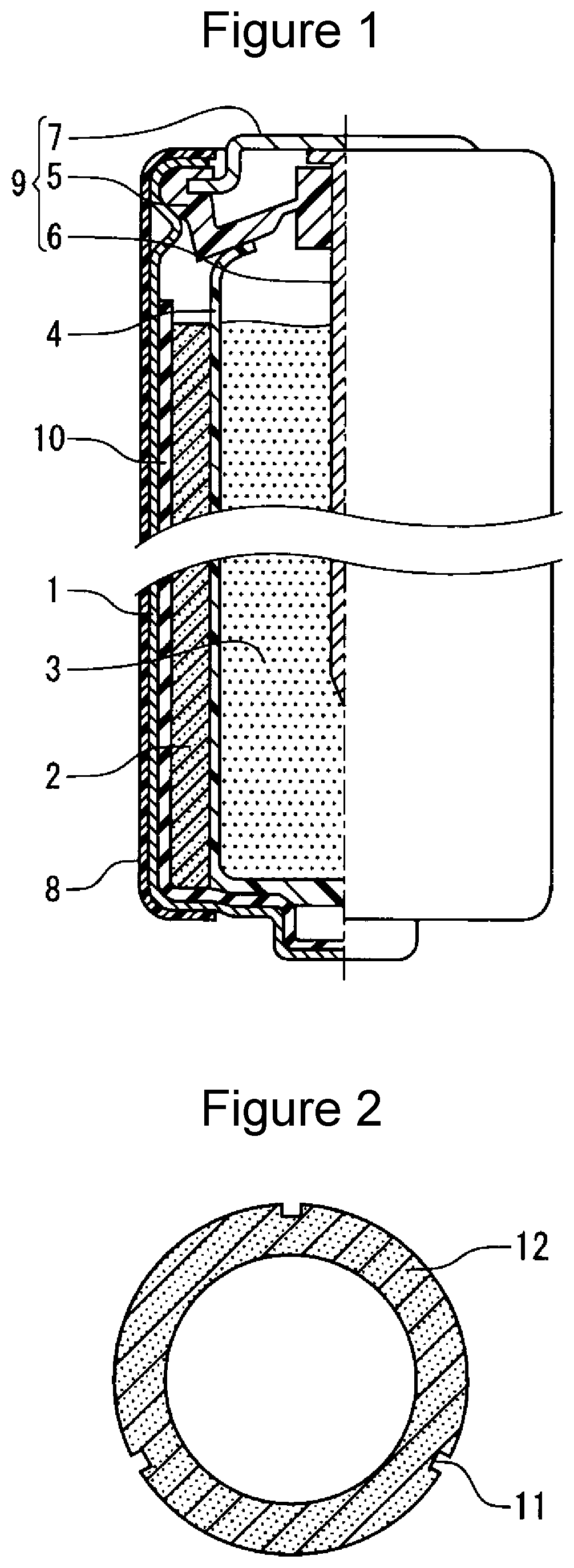Alkaline dry batteries
- Summary
- Abstract
- Description
- Claims
- Application Information
AI Technical Summary
Benefits of technology
Problems solved by technology
Method used
Image
Examples
example 1
[0062]Cylindrical AA alkaline dry batteries (LR6) illustrated in FIG. 1 were produced in accordance with the following procedures (1) to (4).
[0063](1) Fabrication of Positive Electrode
[0064]A graphite powder (average particle size (D50): 8 μm) as a conductive agent was added to an electrolytic manganese dioxide powder (average particle size (D50): 35 μm) as a positive electrode active material to give a mixture. The mass ratio of the electrolytic manganese dioxide powder to the graphite powder was 92.4:7.6. The electrolytic manganese dioxide powder used had a specific surface area of 41 m2 / g. 1.5 Parts by mass of an electrolytic solution was added to 100 parts by mass of the mixture, and the resultant mixture was sufficiently stirred and compacted into flakes. A positive electrode mixture was thus obtained. The electrolytic solution used was an alkaline aqueous solution containing potassium hydroxide (concentration: 35 mass %) and zinc oxide (concentration: 2 mass %).
[0065]The flaky...
example 5
[0085]A granular positive electrode mixture was compacted using a predetermined mold to give two hollow cylindrical positive electrode pellets 12 illustrated in FIG. 2. The positive electrode pellet 12 had three recesses 11 on its outer peripheral surface. The three recesses 11 were disposed at regular intervals in a cross section perpendicular to the axial direction of the positive electrode pellet 12, and each recess extended along the axial direction of the positive electrode pellet 12. The three recesses were 0.5 mm in depth and 1 mm in width.
[0086]A hydrophilic layer was formed on the inner surface of a battery case in the same manner as in EXAMPLE 1. The two positive electrode pellets 12 were vertically inserted into the battery case. During this process, the recesses 11 in the two positive electrode pellets 12 were aligned with one another using a predetermined jig. Thereafter, the two positive electrode pellets were pressed to form a positive electrode in close contact with ...
example 6
[0088]Two hollow cylindrical positive electrode pellets having three recesses on the outer peripheral surface were fabricated in the same manner as in EXAMPLE 5. A hydrophilic layer was formed on the inner surface of a battery case in the same manner as in EXAMPLE 2. The two positive electrode pellets were vertically inserted into the battery case while aligning the recesses of the two positive electrode pellets with one another. Thereafter, the two positive electrode pellets were pressed to form a positive electrode in close contact with the inner wall of the battery case.
[0089]An alkaline dry battery A6 was fabricated and evaluated in the same manner as in EXAMPLE 1 except for the above. The content Ma and content Mb of the hydrophilic material were as described in Table 2.
[0090]The evaluation results are described in Table 2. Table 2 also shows the evaluation results of the batteries A1 and A2 of EXAMPLES 1 and 2.
TABLE 2DischargeContent MaContent Mbperformance(mass %) of(mg / cm2) ...
PUM
 Login to View More
Login to View More Abstract
Description
Claims
Application Information
 Login to View More
Login to View More - R&D
- Intellectual Property
- Life Sciences
- Materials
- Tech Scout
- Unparalleled Data Quality
- Higher Quality Content
- 60% Fewer Hallucinations
Browse by: Latest US Patents, China's latest patents, Technical Efficacy Thesaurus, Application Domain, Technology Topic, Popular Technical Reports.
© 2025 PatSnap. All rights reserved.Legal|Privacy policy|Modern Slavery Act Transparency Statement|Sitemap|About US| Contact US: help@patsnap.com

